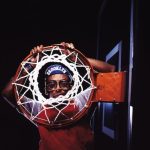“I hope that the fans of the book will see in this movie a loving adaptation that stands on its own as a film,” Matthew López says of his directorial debut, rom-com Red, White & Royal Blue (on Prime Video August 11th). Though this is López’s first endeavor as a filmmaker, he comes to the project as a major fan of its source material: Casey McQuiston’s beloved New York Times best-selling novel.
López is known for writing the Tony Award-winning Broadway play The Inheritance, inspired by the 1910 novel Howards End by E. M. Forster. Both stories are queer, though The Inheritance is a loving portrait of New York’s gay community following the AIDS crisis, while Red, White & Royal Blue is a sugary rom-com that plays with the enemies-to-lovers trope. The story chronicles the steamy, clandestine romance of American first son Alex Claremont-Diaz (The Kissing Booth’s Taylor Zakhar Perez) and Britain’s Prince Henry (Cinderella’s Nicholas Galitzine). López spoke to W about moving from theater to film and why he approaches sex scenes as if they were songs from a musical.
When did you first come across Casey McQuinston’s Red, White & Royal Blue?
I read the book in early 2020, and I didn’t see a musical, but I definitely saw a movie. I fell madly in love with Alex and Henry. I remember feeling overwhelmed by it all and wanting to take that emotion that the book caused in me and channel it into a movie.
With the book’s ready-made fanbase, how did you walk the line between bringing your vision to this story while honoring its source material?
As an enormous fan, I was predisposed to wanting to honor the book. I’m sure one day I will be sent something to fix but here, my job wasn’t to fix anything—it was to protect and shepherd it. When I saw the first assembly of the film last August, which was a third longer than it ended up being, what was clear is that if it’s not about Alex and Henry, it’s not going in the movie. There’s less than 20 seconds in which one of both doesn’t appear. That became a real clear mandate that the film demanded of me.
López on set of Red, White & Royal Blue
Amazon Prime
In the film, Henry references Wong Kar-Wai’s 2000 queer film In The Mood For Love. How did that nod come about?
We were shooting a scene being done as a oner (shot in one-take). Given the distance we wanted to start at and end at, the scene was too short for the camera move. I told Taylor: “Ask him what his favorite movie is.” Nick said, “Golly! I don’t know. You tell me.” I said “Let’s do In The Mood For Love.” There’s something about Henry’s worldliness that would draw him in. We could have picked Happy Together, another Kar-Wai film I love, but for sheer romanticism, you can’t beat In The Mood For Love.
Speaking of romantic dramas, what films were your inspirations?
The most instructive for me is Bringing Up Baby. In a weird way, you could it’s a precursor to Red, White & Royal Blue. Katharine Hepburn’s character, this human cannonball, upends the orderly life of this rule-following Cary Grant. The mayhem and chaos that ensues is so wonderful, I made sure that Taylor and Nick watched it.
The royal family is a dicey subject in the UK, and it’s at the center of your film. How was approaching the divisive topic of the royal institution?
We decided to make it simple for ourselves because to do otherwise would put us in a rabbit hole. The trappings of the royal family were evident in the production design, costume design, and our royal etiquette advisor. I wanted it to look and feel authentic to our understanding as movie watchers.
While the trappings of royalty make for fun cinema, it was always about this one individual who happens to be a royal. We freed ourselves from the expectation to deliver any idea of what a real or movie prince is. (Nick) didn’t have to be something from Disney.
Nicholas Galitzine as Prince Henry and Taylor Zakhar Perez as Alex Claremont-Diaz in Red, White & Royal Blue
Amazon Prime
There’s a sweet moment in the Victoria and Albert Museum. Why did you shoot in that sculptural exhibition?
That’s not the gallery from the book. I went there with Stephen Goldblatt, my director of photography, and it wasn’t very cinematic. Stephen took me to another part of the museum, where we shot, with lower ceilings a more contained space with beautiful statues: David and Goliath, three women, the corridor of busts and torsos—very cinematic.
It’s one of my favorite spots in London.
Yeah, my worry for the V&A is that within two weeks that hallway will be flooded with people dancing in that little corridor.
Galitzine and Zakhar Perez in Red, White & Royal Blue
Amazon Prime
How was shooting intimate scenes for film, compared to theater?
Intimacy on-stage is difficult, bordering on impossible. (Though) you have a lot more creative solutions to a physical limitation. Film is a much more literal medium than theater. They have great robust sex in the book, it’s a big part of their relationship and had to be a part of the film. I worked with an amazing intimacy coordinator, Robbie Taylor Hunt. We talked about intimacy scenes being like songs in a musical; songs in a well-constructed musical should tell you about the characters and propel the story.
The last thing you want to say to an actor engaging in intimate scenes (who’s asking), “Why am I doing this?” is, “Because it’ll look good.” That’s not sufficient. The scene isn’t just sex, it’s a communion: it’s the first time Alex has had penetrative sex with another man and it is, Nick and I decided, Henry’s first time having sex with a man he has real feelings for. The challenge for the scene was: can we stay on their faces full frame, show enough of their bodies to understand the geography of what is happening, and can we allow the actors to act this scene of intimacy rather than merely perform the intimate scene.
As a director and then as a fan, what is your favorite Red, White & Royal Blue scene?
As a director, my favorite moment is a scene in Alex’s bedroom after they hook up. That is me, Taylor and Nick all working at our best. Their chemistry is off the charts, their friendship as actors and their trust in me as their director and my absolute love of them as people is evident on screen. As a book fan… I’ll cheat, we did a fan screening in London. In the novel, the line “History, huh? Bet we could make some,” is not spoken. When Alex speaks that line in the movie, the entire audience of fans cheered. That moment was pretty great.



